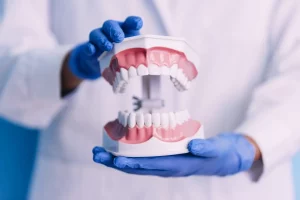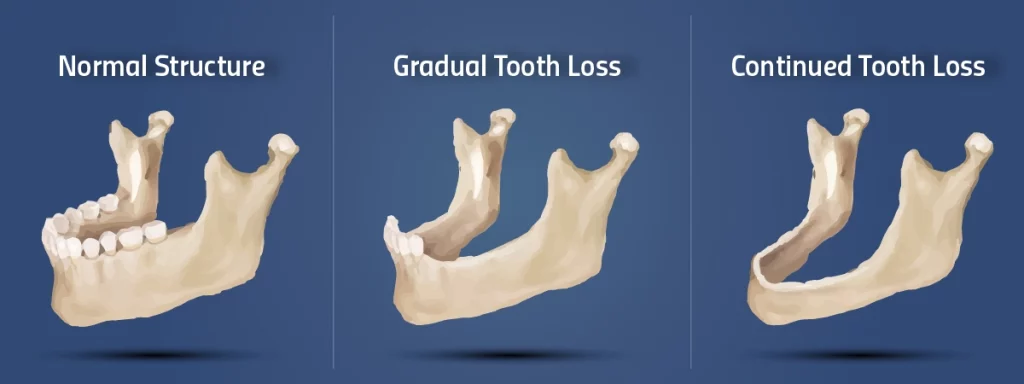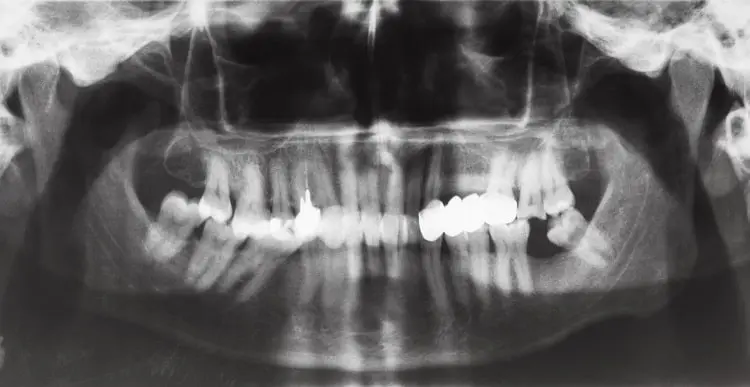Last Updated on: 4th December 2024, 04:14 pm
Bone is living tissue, made up of a compact layer on the outside and spongy tissue on the inside. As living tissue, dental bone cells are designed to self-destruct and regenerate over time, maintaining the jaw. The cells are osteoblasts (cells that produce bone) and osteoclasts (cells that destroy bone). Bones also contain blood vessels, nerves, protein, vitamins, and minerals. However, with aging, these cells lose their replacement functions. In addition, some diseases can cause bone loss in the jaw and other parts of your body.
Table of Contents
ToggleWhat is the Function of Bones?
All the bones of the body have the main function of providing support and stability to the muscles, but the bones in the mouth fulfill a particular function:
- Maxillary bone: As the largest bone in the upper part of the face, it forms the roof of the mouth (hard palate) and part of the eye socket (eye socket). This bone also contains the upper teeth.
- Mandibular bone: As the strongest bone of the face, it forms the lower part of the jaw and the lower portion of the mouth, containing the lower teeth.

The deterioration of the bone of both the maxilla and the mandible is a problem that many people do not understand well since the main cause of bone loss is a lack of teeth. Dental pain is a major cause of dental consultation; people opt for extractions before carrying out a maintenance treatment.
What Other Causes Engender Bone Loss?
Although the main cause of bone loss is missing teeth, other factors can contribute to bone loss:
1. Dentures
They are the most traditional and inexpensive method used to replace missing teeth; however, their use causes bone loss since they rest against and move directly on the gums that cover the bone. This does not provide enough stimulus for bone turnover, thereby causing the loss. Over time, dentures become unsuitable and must be changed.
2. Periodontal disease
A gum infection or other periodontal disease affects dental support structures (gums and bone); and in very advanced stages, they also cause tooth loss. If periodontal disease is not treated, it causes damage to the strength and stability of the tooth and the jaw.
3. Trauma
Injuries or direct blows to the teeth are associated with bone loss. When the tooth falls out or is lost, the usual bone replacement stimulus is also lost. On the other hand, fractures also affect the jawbone, which tends to lose its quality over time.
4. Medical conditions
Some conditions or diseases may be associated with bone loss:
- Osteoporosis is a disease that causes the jawbone to become weak and brittle.
- Paget’s disease is a condition that disrupts the replacement or regeneration process of bone.
- Osteomyelitis is an inflammation of bone tissue caused by an infection.
- Tumors are another cause of bone deterioration.
5. Dental misalignment
Dental crowding or misalignment can cause an accumulation of bacterial plaque if good oral hygiene is not practiced. This accumulation causes the bacteria to directly attack the supporting tissues of the teeth, causing their loss.
Other causes that cause bone loss
In addition to those already mentioned, there are other causes that can cause bone loss:
- Infections in the mouth are mainly associated with bacteria
- Birth defects (hereditary diseases)
- Smoking
- Medications such as bisphosphonates cause damage to bone density.
- Orthodontic treatments are associated with bone loss. If the treatment does not have adequate controls or the patient uses the appliances for “luxury”, they can cause plaque accumulation and periodontal disease. The excessive force of some appliances as well can cause bone loss.
What are the Consequences of Bone Loss in the Jaw?
One of the consequences of tooth loss is the affectation of oral health; however, at first sight, the profile and aesthetics of the affected person are known as facial collapse. In this case, the mouth seems to fall back on the face, and the chin becomes more pointed, giving an appearance of sadness or even a bad temper. The muscles of the face also weaken, which leads to premature wrinkles and a thinning of the lips. Overall, the person looks much older.
In addition to the effects mentioned, bone loss can also cause malnutrition since having neither teeth nor bone to chew optimally, food intake will not be so easy.

Likewise, bone loss also affects the stability of the remaining teeth (if any), causing them to move out of place. Other manifestations of bone loss are:
- Headaches
- Pain in the face
- Difficulty speaking
In some cases, depending upon the degree of bone loss, the ability to undergo some dental treatments can be limited, especially dental implants since these depend on bone tissue, both in quantity and quality.
Can Lost Bone be Recovered?
If the bone loss is caused by periodontal disease and the loss is not generalized, that is, only lost in small areas of the mouth, regenerative surgery treatments can help resolve the bone loss. These treatments are not for everyone. A specialist dentist should be consulted to find out if a procedure is suitable; and if so, the treatment should be carried out in a timely manner.
There is reconstructive surgery by a bone graft. It can be donated (allograft) from the same patient (autograft), from another animal species previously treated and processed (exograft), or it can be of synthetic origin (alloplastic). This type of procedure must be evaluated and then performed by a specialist. It will depend upon the amount of tissue to be reconstructed since if they are very large areas, the treatment will not be successful.
How can Jaw Bone Loss be Prevented?
Whatever the cause, there are treatments that help prevent bone loss, as long as these measures are undertaken early and not when the loss is extensive and widespread.
Dental implants
Dental implants are the most appropriate treatment option since they resemble the natural tooth both in the crown and the root. They prevent the bone from wearing out because they continue its main function, which is stability and support for the tooth.
Alveoli preservation
The alveoli are the pockets where the teeth are housed, if there is no tooth, they lose their function and begin to flatten. However, this can be avoided through bone grafts.
Lifestyle change
Bones require calcium, vitamin D, protein, and phosphorus among other essential nutrients. These are provided through the diet; therefore, a well-balanced diet must be followed to maintain bone health.
Quit smoking
The consumption of nicotine through cigarette smoking not only affects lung health but also has detrimental effects on the bone tissues of the body. Nicotine, present in cigarettes, poses risks to both overall health and bone strength. Therefore, avoiding smoking and maintaining a healthy lifestyle are crucial steps to protect the well-being of your lungs and bones.
Periodic visits to the dentist
It is important to visit the dentist for prevention and to carry out dental cleanings and examinations, plus any treatment if there already is the presence of a disease.
It is important to bear in mind that any disease is avoidable as long as you have good eating habits, a healthy lifestyle, and make regular visits to the dentist for prevention. The dentist is trained to manage the disease in a timely manner or will refer you to a periodontics specialist if necessary.
Contact us
If you have any questions about this or other topics, you can contact us at Channel Islands Family Dental as well as our page on Facebook. We look forward to your visit and we will make a timely diagnosis. Our dentists in Oxnard, Santa Paula, Ventura, Newbury Park, and Port Hueneme will be able to guide you toward the best treatment to take care of your health and give you back your best smile.
Bibliography
- Elseiver. (April 4, 2015). Clinical journal of periodontics, implantology and oral rehabilitation. Obtained from Osteology: relevance of medical concepts in: https://scielo.conicyt.cl/pdf/piro/v8n1/art13.pdf
- KidsHealth. (January 1, 2019). KidsHealth. Retrieved from Bones, Muscles, and Joints: https://kidshealth.org/en/parents/bones-muscles-joints.html
- Martinez Alvarez O, BA (January 9, 2018). Advances in odontostomatology. Obtained from bone grafts and biomaterials: https://scielo.isciii.es/pdf/odonto/v34n3/0213-1285-odonto-34-3-111.pdf
- Medicine. (March 11, 2016). PubMed. Retrieved from Does orthodontic treatment affect alveolar bone density?: https://www.ncbi.nlm.nih.gov/pmc/articles/PMC4998922/
- National Library of medicine. (November 5, 2015). Frontiers in Physiology. Retrieved from Bone resorption: a player in dental and periodontal development?: https://www.ncbi.nlm.nih.gov/pmc/articles/PMC4633481/
- Scielo. (February 1, 2006). Oral Medicine, Oral Pathology and Oral Surgery. Obtained from Physiological bases of bone regeneration I. Histology and physiology of bone tissue: https://scielo.isciii.es/scielo.php?script=sci_arttext&pid=S1698-69462006000100011
- Scielo. (July 1, 2006). Oral Medicine, Oral Pathology and Oral Surgery. Retrieved from Periodontal regeneration in clinical practice: https://scielo.isciii.es/scielo.php?script=sci_arttext&pid=S1698-69462006000400017
- UTSouthwestern Medical Center. (March 9, 2022). med blog. Retrieved from Osteonecrosis of the Jaw: Treatment of Bone Loss Triggered by Osteoporosis Medications: https://utswmed.org/medblog/osteonecrosis-jaw-treatment/



